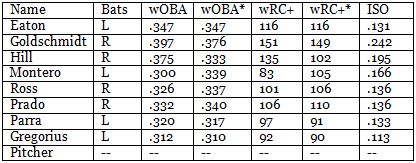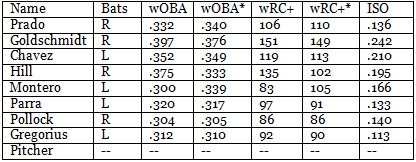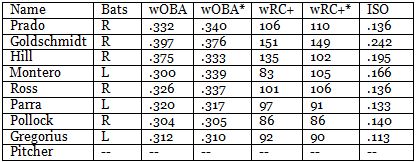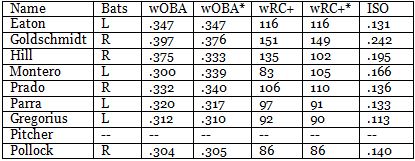Fun with Lineups: A Few Suggestions for Kirk Gibson
If you’ve read Jeff Wiser’s piece on lineup construction, you know that the difference between one lineup and another is pretty small in terms of runs scored. Still, the construction of a lineup is second only to bullpen alignment in terms of how something other than player performance affects games. And everyone has something to say. There are a few things we’ve seen lately that I don’t love, like Tony Campana or A.J. Pollock in the leadoff slot or like Martin Prado hitting into a horrendous number of double plays. I’d like to lay out a few lineups that I’d very much like to see.
For purposes of this exercise, I’m going to pretend it’s late July or early August of this year. With the exception of Adam Eaton, the players who got the lion’s share of playing time this year are likely to do the same again next year. Eric Chavez is the only player out of that group who is not signed for next year. Re-signing him is not certain – it would be difficult to play Matt Davidson most games if Prado and Chavez are both on the roster. As for Cody Ross, I’d like to think he’ll be back and that he’ll be substantially the same player. He may not be one of the league leaders on defense again, and he probably will only play about half-time to start, especially given the number of other outfield options – but he’s in this mix.
The player pool for today: Outfielders – Adam Eaton, A.J. Pollock, Gerardo Parra, Cody Ross
Infielders – Paul Goldschmidt, Aaron Hill, Eric Chavez, Didi Gregorius, Martin Prado
Catcher – Miguel Montero
There are only five guys in the above group that I expect will play substantially every day, coming out of the lineup only for rest, rather than because of a time share: Goldy, Hill, Parra, Montero, and Prado. Parra may lose a few extra plate appearances there, but since he’s been the D-backs’ most valuable outfielder this season – 8th in fWAR among NL outfielders – I’d say he continues to start just about every day. Re: shortstop – no matter how you slice it, Arizona is set to receive below-average offense from shortstop, as all three options (Gregorius, Cliff Pennington, Willie Bloomquist) have been below the 100 mark in Weighted Runs Created Plus (wRC+). So I’m just going to go with Gregorius here, as sort of a sixth “everyday” guy.
That leaves only Eaton, Pollock, Ross, and Chavez as time share guys to split two lineup spots. To account for a few different alignments, I’ve got four different lineups below. Four groups:
A: Parra, Eaton, Ross (OFs); Goldy, Hill, Gregorius, Prado (INFs); Montero (C).
B: Parra, Prado, Pollock (OFs); Goldy, Hill, Gregorius, Chavez (INFs); Montero (C).
C: Parra, Pollock, Ross (OFs); Goldy, Hill, Gregorius, Prado (INFs); Montero (C).
D: Parra, Eaton, Pollock (OFs); Goldy, Hill, Gregorius, Prado (INFs); Montero (C).
One last note before we start: I’m going to use statistics from this year, also listing a career wOBA for reference. But Adam Eaton hasn’t given us enough to work with yet. In 562 plate appearances at AAA last year, Eaton had an amazing .440 wOBA, and a wRC+ mark (163) that put him 63% better at creating runs than the average AAA hitter. We can’t give him the benefit of that, because it’s AAA, and it’s Reno; but we should probably walk up his numbers from their current .329 wOBA, 103 wRC+ levels. I’m going to use the Steamer rest-of-season projections for those rate stats (.347 wOBA, 116 wRC+), although I think we can be cautiously optimistic that he’ll be better than that in 2014. By the way — if you don’t know these statistics, please refer to the FanGraphs glossary (link’s to your right). If you’d rather not read a post that uses them, well, (door’s on your left).
Here’s Lineup A (an asterisk (*) denotes a “career” statistic):
Each one of these lineups is going to introduce a new wrinkle worth a little discussion. I’m not going to bother going into detail about why Eaton should be at the top of the lineup because Jeff already has; Eaton’s the rare speedster who promises to have a strong on base percentage, and he belongs in the lineup.
The thing you’re probably most alarmed about is Goldy batting second. Why did I do that? Well, mostly for these reasons. His wOBA dwarfs everyone else’s, and I’d rather get him the extra 18 at-bats per year that Jeff referred to in his lineup piece — especially when you consider that if Goldy gets on base once or twice more than the alternative in those 18 spots, the player after him will get a chance to bat, too. If you really wanted to swap Goldy and Hill, I wouldn’t object.
The other aspect of this lineup that surprised me a bit is Montero. Going off of this year’s stats, you’d be tempted to drop him; his wOBA and wRC+ marks are worst among these eight guys. Maybe his body is barking at him, but at just 30 years old, he’s a little young to be breaking down. And while there’s such a thing as a sunk loss, Arizona doesn’t have much margin for error; the club needs most of the bets it’s made to pay out. Montero has four years left on that five year, $60M contract, so count him among the organization’s biggest bets.
So I’m banking on Montero bouncing back toward his career levels. Using career numbers, there isn’t a big difference between Montero, Ross and Prado; despite the dip in numbers this season, Montero gets the nod at cleanup because he bats left handed and because even in a down year, Montero’s isolated power (SLG – AVG = ISO) suggests that a bigger chunk of his hits go for extra bases.
Lineup B:
Well, that’s new. With no Eaton, there’s no obvious leadoff guy in this group. Pollock has the worst wOBA of the bunch, so it would be foolhardy to put him up there. We don’t want Goldy in that spot, and because of his knees and his ISO, we don’t want Chavez up there (although it might give him some extra PAs, if generally he’s going to get subbed out). I’d be happy with Hill in that spot. But what about Martin Prado?
Prado has the third-highest career wOBA in this group – same with career wRC+. Maybe we want him to get at-bats, in general. But his route to the basepaths has been through groundballs – he’s hit them 47.8% of the time when he makes contact, eking out Pollock for second-highest in GB% among these 8 guys (Parra’s, by the way, is an astronomical 56.5%). Ground balls are a big part of why Prado is second among all hitters in major league baseball with 26 GIDP this year… and that’s been tough to watch, even if GIDP are mostly about luck and probably not something we want to design a lineup around.
But with his steady OBP/wOBA presence, there are other reasons to want Prado in the leadoff spot. So we’ll indulge. With Prado in the leadoff spot, at least once per game, we’re guaranteed that he can’t hit into a double play! And it may go a little further than that – consider that if the pitcher is up with a man on and less than 2 outs, he’s probably going to bunt. If he bunts, he’s probably going to be successful at moving a guy over, even if he’s probably also going to be thrown out himself. That might mean that the guy manning the leadoff position is a little less likely to get PAs with a man on first (there’s also the fact that the guys at the bottom of the lineup get on base less in the first place). Something to consider.
Lineup B is also the “Chavez Lineup,” and if Prado bats first, you might bump Chavez from cleanup to third just to avoid three RHH in a row – and to avoid three LHH in a row. Handedness shouldn’t be king, but that’s a stark difference. So this lineup may be the one of the four for which Goldy batting second matters most. You’re not going to bump Goldy down to 4th.
Lineup C:
No Eaton again, so Prado’s back atop the lineup. Ross is back, and might benefit from this slot in between Montero and Parra; even though he’s only shown a modest career platoon split (.297 v. LHP, .250 v. RHP), that gap widened in an enormous way in 2013 (.391 v. LHP, .217 v. RHP). Some of that might be from the time share, but that’s a pretty huge difference. If opposing managers bring in a lefty to face Montero, they may be tempted to leave him in to face Parra; and Ross might feast.
Other than that, there’s not much that’s controversial about this lineup that wasn’t discussed above. Yes, we do start with three RHH, but I can’t see Montero being put ahead of either Goldy or Hill. It wouldn’t be ridiculous to consider putting Parra in the 2-hole and bumping everyone else down, but I don’t think the juice is worth the squeeze.
Lineup D:
Eaton’s back in this lineup, and everyone else falls into order as we’ve seen in other lineups. Well, all but the last guy…
This is the only group of the four we’ve looked at that has both Eaton and Pollock (although I might treat Tony Campana the same way I have Pollock here). As Jeff has discussed, Pollock is not an ideal leadoff guy – although in non-OBP respects, he seems like one. In American League lineups, it’s not unusual to bat that type of guy 9th, as kind of a supplemental leadoff man. It’s advantageous to avoid having an offensive black hole lead into the top of the lineup – that benefit can be more important, ever-so-slightly, than the having the pitcher bat earlier. as Sky Kalkman at Beyond the Box Score noted, this trade-off is worth an extra two runs or so per season. This lineup configuration was famously used in the latter half of 1998 by Tony La Russa, and again about ten years later. Joe Girardi did it in May, and Joe Maddon did it less than a month ago.
So if that’s so smart, why didn’t we do this with the other two Pollock lineups? Well, neither of those lineups featured Adam Eaton. One of the great strengths of the Arizona roster is flexibility. Yes, there’s the Prado flexibility; but having Pollock, who is more than a true fourth outfielder, is a big part. A good double-switch option in many games may be entering Pollock as a pinch hitter and defensive replacement (in which case he might be batting ninth anyway). In this lineup, we can’t have Eaton take over for Pollock in the field if Pollock is the one to get switched out – so if both players are going to stay in the game, they’re not going to be involved in substitutions.
Batting Pollock ninth is closely related to the idea of batting Goldy second, so if you’re not in for the latter, you’re probably less likely to be in for the former. It would be a good tool to have the ol’ tool belt, though.
How about it, D-backs fans? What do you think of these lineups? Tweet me at @InsidetheZona!
Please note: I am indebted to FanGraphs for nearly all of the statistics above. Many thanks to those folks.
Recent Posts
@ryanpmorrison
 Congrats to @OutfieldGrass24 on a beautiful life, wedding and wife. He deserves all of it (they both do). And I cou… https://t.co/JzJtQ7TgdJ, Jul 23
Congrats to @OutfieldGrass24 on a beautiful life, wedding and wife. He deserves all of it (they both do). And I cou… https://t.co/JzJtQ7TgdJ, Jul 23 Best part of Peralta’s 108 mph fliner over the fence, IMHO: that he got that much leverage despite scooping it out… https://t.co/ivBrl76adF, Apr 08
Best part of Peralta’s 108 mph fliner over the fence, IMHO: that he got that much leverage despite scooping it out… https://t.co/ivBrl76adF, Apr 08 RT @OutfieldGrass24: If you're bored of watching Patrick Corbin get dudes out, you can check out my latest for @TheAthleticAZ. https://t.co/k1DymgY7zO, Apr 04
RT @OutfieldGrass24: If you're bored of watching Patrick Corbin get dudes out, you can check out my latest for @TheAthleticAZ. https://t.co/k1DymgY7zO, Apr 04 Of course, they may have overtaken the league lead for outs on the bases just now, also...
But in 2017, Arizona ha… https://t.co/38MBrr2D4b, Apr 04
Of course, they may have overtaken the league lead for outs on the bases just now, also...
But in 2017, Arizona ha… https://t.co/38MBrr2D4b, Apr 04 Prior to the games today, there had only been 5 steals of 3rd this season (and no CS) in the National League. The… https://t.co/gVVL84vPQ5, Apr 04
Prior to the games today, there had only been 5 steals of 3rd this season (and no CS) in the National League. The… https://t.co/gVVL84vPQ5, Apr 04
Powered by: Web Designers@outfieldgrass24
 What is/are the best bottle shops in Seattle and can Cloudburst be found in them?, Sep 16
What is/are the best bottle shops in Seattle and can Cloudburst be found in them?, Sep 16 Cool that Seattle gets the '23 ASG. Who is/are the #Dbacks representative/s in the 2023 Mid Summer Classic?, Sep 16
Cool that Seattle gets the '23 ASG. Who is/are the #Dbacks representative/s in the 2023 Mid Summer Classic?, Sep 16
Powered by: Web Designers








